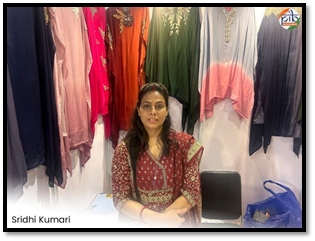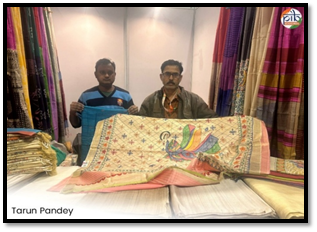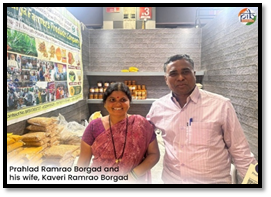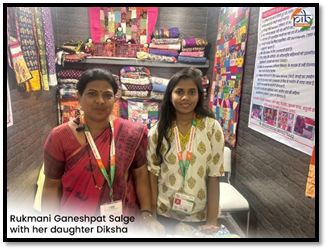PIB Headquarters
Enterprise on Display: IITF Strengthens Small Businesses & Rural Entrepreneurs
Posted On:
23 NOV 2025 12:07PM by PIB Delhi
The Bharat Mandapam complex has transformed into a dynamic showcase of India’s economic diversity, bringing together traditional crafts, farm enterprises, startup innovations, and regional specialities from across states. The 44th India International Trade Fair (IITF) 2025, themed Ek Bharat, Shreshtha Bharat (One India, Great India) with more than 3,500 participants, each carrying her own story of labour, heritage, and aspiration.
Inaugurated on 14 November 2025, the fourteen-day event is not merely a commercial gathering but an opportunity platform where first-generation entrepreneurs, rural artisans, and home-grown brands test their demand, connect with buyers, learn from peers, and access state support mechanisms. For many exhibitors, IITF represents a step into a larger national marketplace—one that reflects a confident, steadily growing, and self-reliant India.
|
Do You Know?

The India International Trade Fair (IITF), organised annually by the India Trade Promotion Organisation (ITPO) since 1980, is one of India’s most significant platforms for MSMEs, artisans, startups and industries to connect with buyers and expand their market reach. Over the years, it has grown into a showcase of India’s manufacturing strength, innovation and traditional crafts across diverse sectors. In 2024, the fair drew over one million visitors, reaffirming its status as one of the country’s most awaited trade events.
IITF is held at Bharat Mandapam, the modern convention and exhibition complex built within the Pragati Maidan precinct and inaugurated in 2023. Developed to provide India with a world-class venue for global exhibitions and major summits, it spans 123 acres and includes a 7,000-seat convention hall, seven exhibition halls, more than 100,000 m² of display area. The ITPO to host nearly 90 events each year, positioning New Delhi as a leading international exhibition destination.
|
Bihar: An Artisan Steps into National Spotlight

At the Bihar pavilion, 45-year-old Sridhi Kumari stands before rows of Bhagalpuri silk and zari workcraft she has honed over 12 years. As a first-time participant at IITF, she embodies the journey of women-led entrepreneurship, showcasing Bhagalpuri silk that holds a Geographical Indication (GI) tag. “I am an authorised seller,” she says, carefully arranging her sarees with evident pride.
She explains that the Bihar government extended support through its women-entrepreneurship schemes. “Our secretary guided me through all formalities,” she shared, emphasising how administrative assistance matters for first-timers. Her craft is a collaboration of skills from Bihar and West Bengal, as her artisans come from both states, reflecting an inter-regional textile exchange.
Another artisan, who previously attended IITF, encouraged her to participate.
“She told me there are strong earning possibilities during and after the fair,” Sridhi says. “How much it will translate into, we will know only after the fair concludes.” Her earlier participation in a GI-Mahotsav during March 2025 helped her earn the equivalent of two to three months of income, giving her confidence to scale further this year.
From Nalanda to Delhi: Weaver Who Returns Every Year
A few rows away, 49-year-old Tarun Pandey from Nalanda adjusts soft Baavanbuti. sarees woven with fine motifs. This marks his eighth participation at IITF. As a traditional weaving artisan, he represents a generational weaving tradition practiced across numerous Bihar villages. Each saree reflects meticulous labour, taking nearly three and a half days to complete, making his work both time-intensive and culturally significant.

He shares that IITF remains his primary annual exhibition. Explaining the income benefit, he said, “I earn the equivalent of nearly two to two-and-a-half months of my income from IITF.”
“We do not participate in other fairs, IITF matters the most,” he added.
His sarees are priced between ₹4,000 and ₹6,000, with intricate ones touching ₹10,000. But what sustains him, he says, are repeat customers who identify him as “the weaver from Nalanda” and return each year.
A Farmer-Turned-Entrepreneur & Expanding Opportunities
51-year-old Prahlad Ramrao Borgad and his wife Kaveri from Maharashtra’s Hingoli district, welcome visitors with neatly packed organic pulses, turmeric, ginger, pickles and other spices. A lifelong farmer, Borgad adopted organic farming in 2012 and formally launched ‘Surya Farmers’ in 2015 with support from his local Self-Help Group and the Micro, Small & Medium Enterprises (MSME) department.

“I saw IITF advertised online and approached the Maharashtra government. They guided us through the application,” he shared. This is his second participation, after exhibiting at IITF 2023. He has also been a part of the SARAS Mela 2024.
“Such platforms are not only about selling products…They help us build contacts, understand consumer expectations, and learn how to present our work professionally. As farmers, we would not learn these things on our own.” Borgad said. According to Borgad, the profit he earns at IITF is equivalent to four to five months of his income. In addition, he also receives orders over the phone once he returns home or after customers try his products.
Preserving a Traditional Art: Godhari From Latur

In the Maharashtra pavilion, Rukmani Ganeshpat Salge from Latur greets visitors alongside her 15-year-old daughter, Diksha. Her stall displays quilts crafted in the historic Godhari art form, a tradition kept alive by generations of women in her region. However, the craft faces pressure from mass-produced alternatives available in the market at lower prices. “This is my first year at IITF,” Rukmani says, as she smoothens the edges of a vibrant quilt.
“Each Godhari quilt takes four to five days of hand-stitching,” she said. These quilts, priced between ₹1,000 and ₹6,000, stand out for their authenticity and detailed workmanship.
For Rukmani, IITF is more than a selling space; it introduces her craft to buyers who value handmade work and helps sustain a tradition that is otherwise at risk of fading.
Jharkhand: Lac Bangles Representing 400 Adivasi Women

Jharkhand, celebrating its 25th year of statehood, is the state in focus at IITF 2025. At its pavilion, artisan 49-year-old Jhabar Mal displays lacquer bangles crafted through traditional techniques passed down through tribal communities. A participant for the past four to five years, he notes that he is the only artisan selling lac bangles at IITF. “I do not earn very high amounts in these 14 days. I come to IITF for my permanent customers who wait for me every year. Some of them even pre-order the bangles and collect them here. This is my sixth year at IITF” he said.
“The orders that come after the fair support nearly 400 Adivasi women who work with me back home in Jharkhand,” Mal added. He is part of the Lah Hasta Shilpa Swabalambi Sahakari Samitee Limited, a cooperative dedicated to sustaining rural livelihoods through craft.
Trade Fairs as Economic Ecosystems
Trade fairs like IITF play a much wider role than facilitating direct sales. They function as economic support systems where small traders gain visibility, secure long-term buyers, and understand market behaviour. Exhibitors often emphasise that post-fair orders matter as much as immediate sales, with many reporting income equivalents to several months.
The 2025 edition aligns with India’s broader vision under Viksit Bharat 2047, highlighting economic resilience, political stability, and expanding trade linkages, including ongoing Free Trade Agreements with various global partners.
As evening lights illuminate the pavilions, the stories behind each stall reflect the remarkable diversity of India’s entrepreneurial landscape. Many exhibitors travel hundreds of kilometres to access a platform that helps them grow, learn, and participate more confidently in the economy. For Sridhi, Tarun, Prahlad, Rukmani, and Jhabar, IITF is a place where tradition meets enterprise, where local skills find national relevance, and where small businesses gain the momentum they need to progress. In its 44th edition, the fair establishes that India’s economic growth emerges not only from large industries but equally from the perseverance, creativity, and ambition of small entrepreneurs who contribute to the country’s evolving marketplace.
References
https://www.pib.gov.in/PressReleseDetailm.aspx?PRID=2190245
https://www.indiatradefair.com/aahardelhi/uploads/pdfs/Aahar%202025%20Fair%20Guide.pdf
https://www.pib.gov.in/PressReleasePage.aspx?PRID=1555538
https://www.pib.gov.in/PressReleasePage.aspx?PRID=2078289
Click here to see PDF
M
(Release ID: 2193109)
Visitor Counter : 227